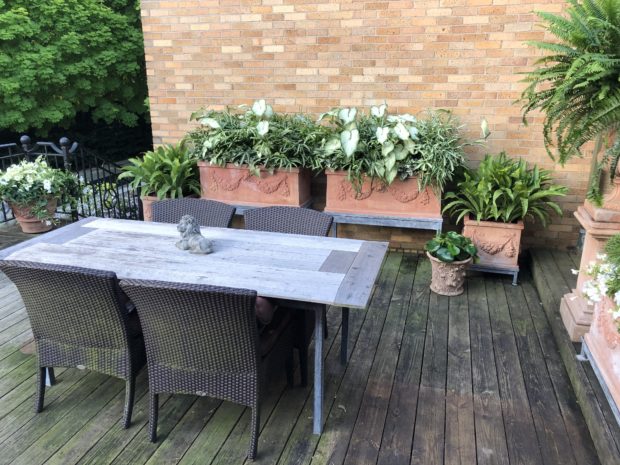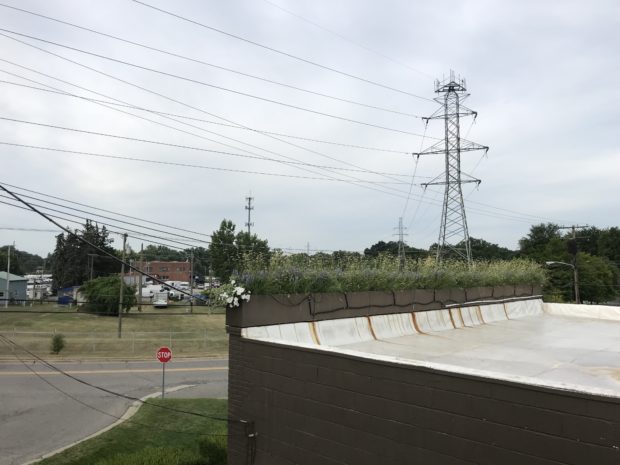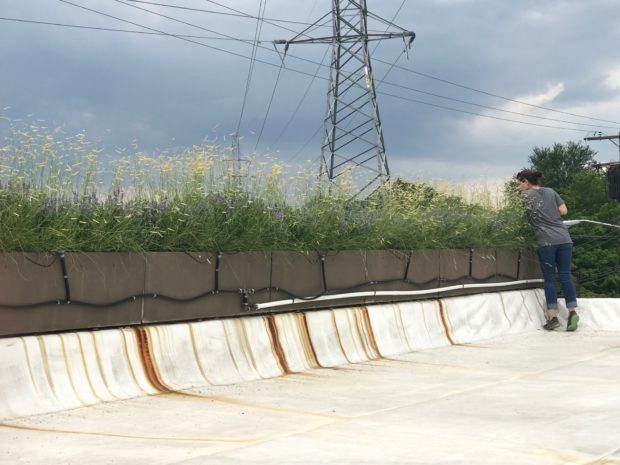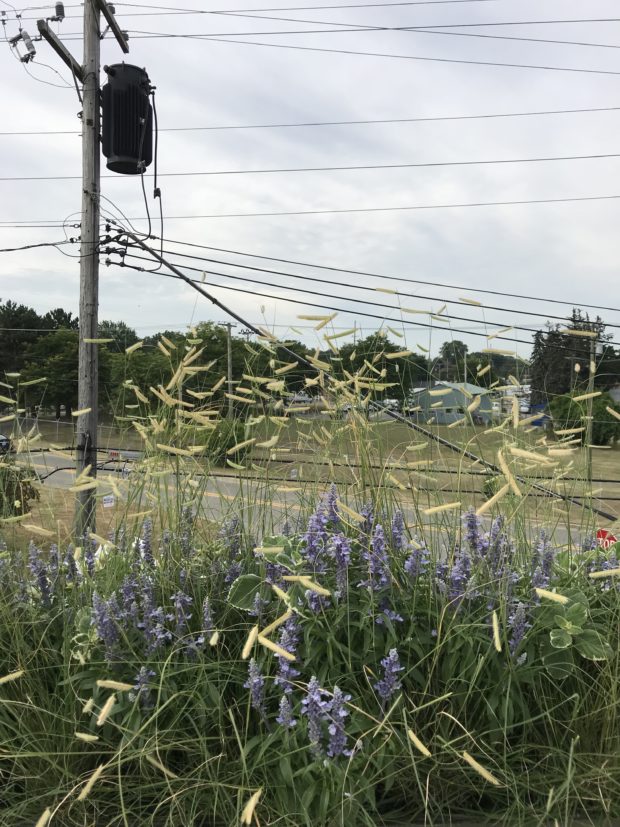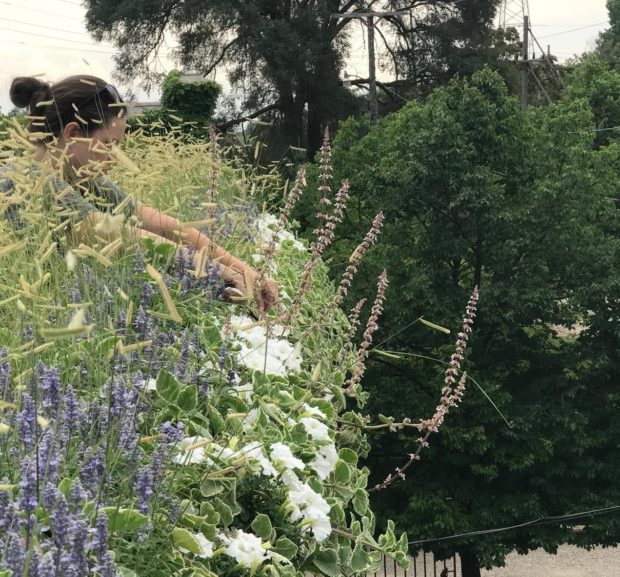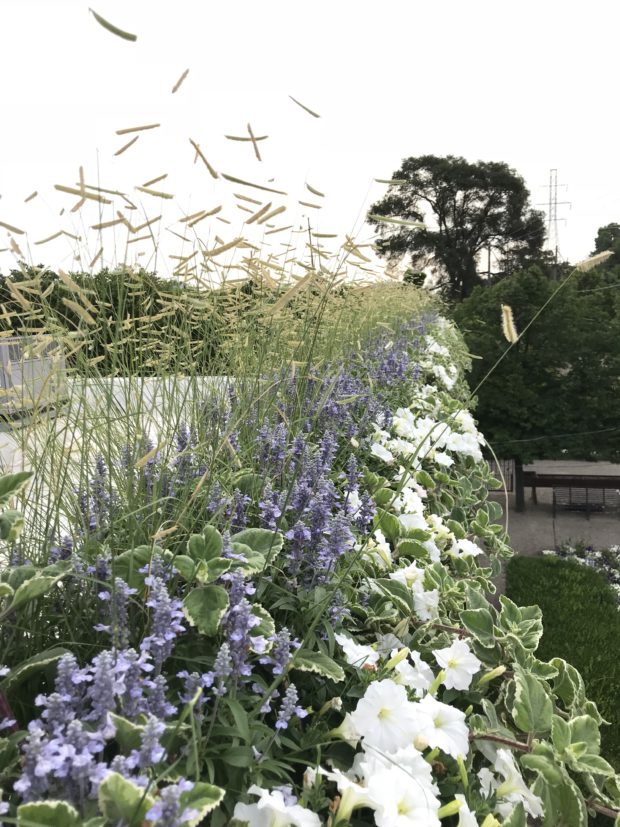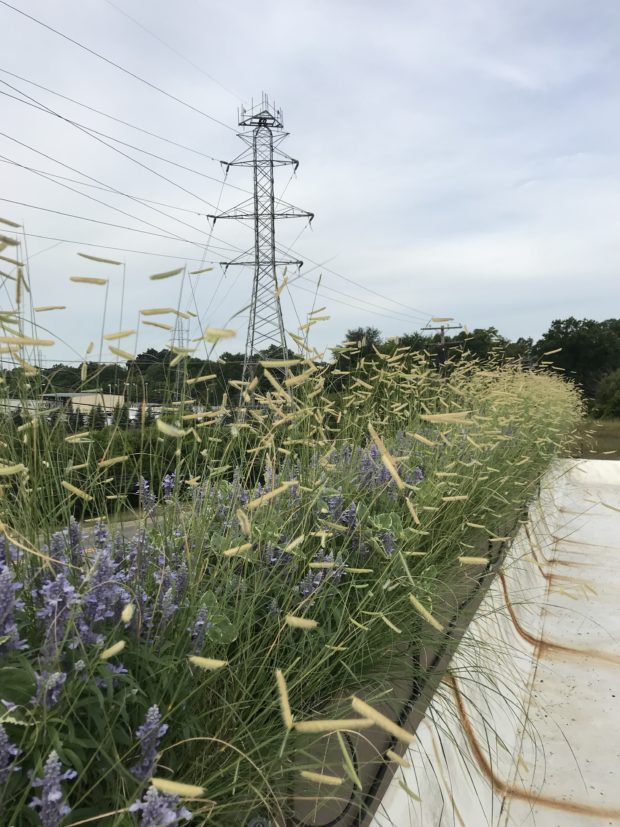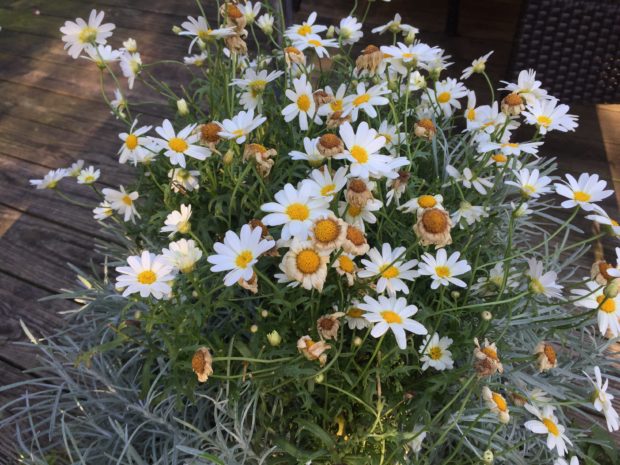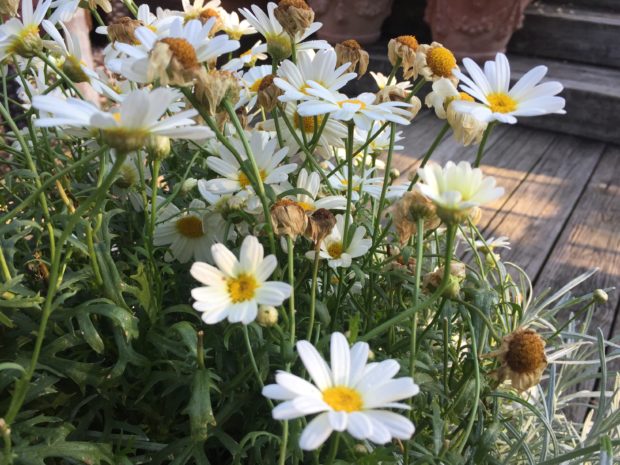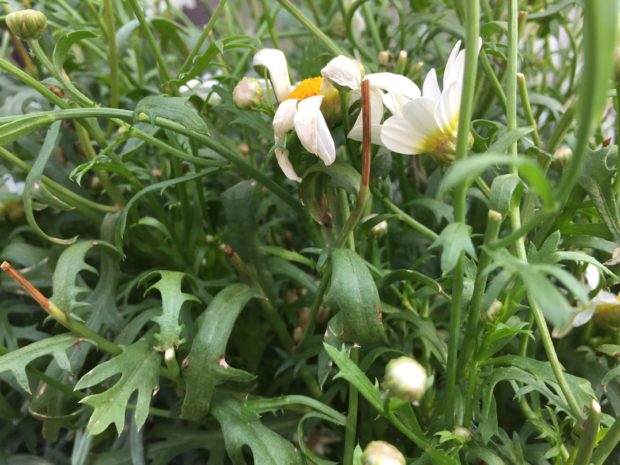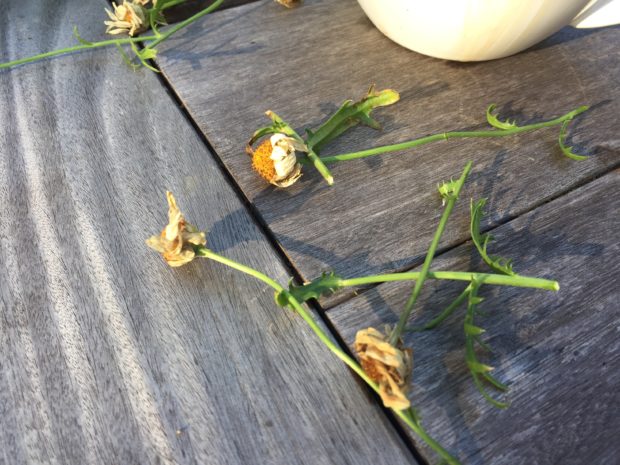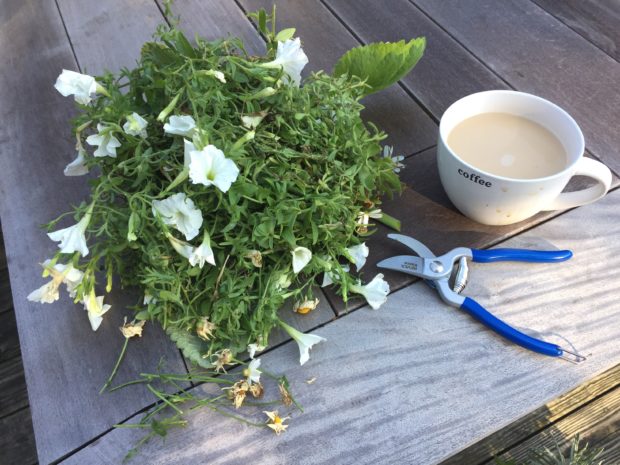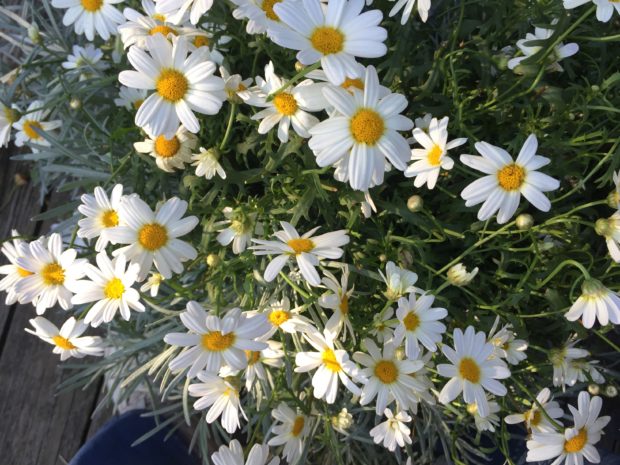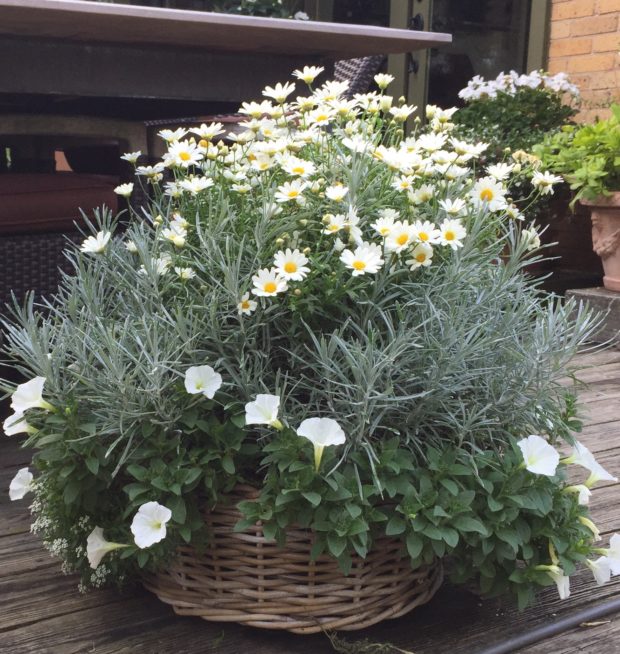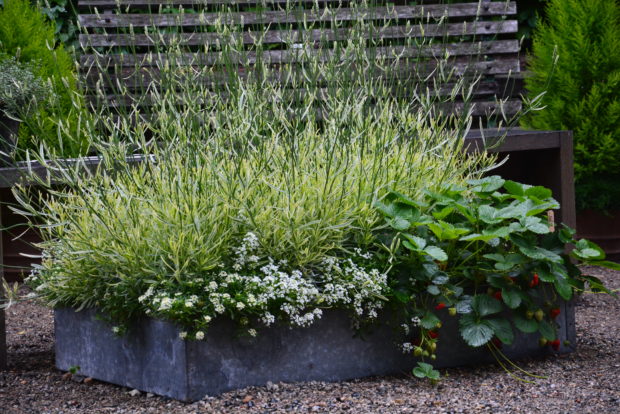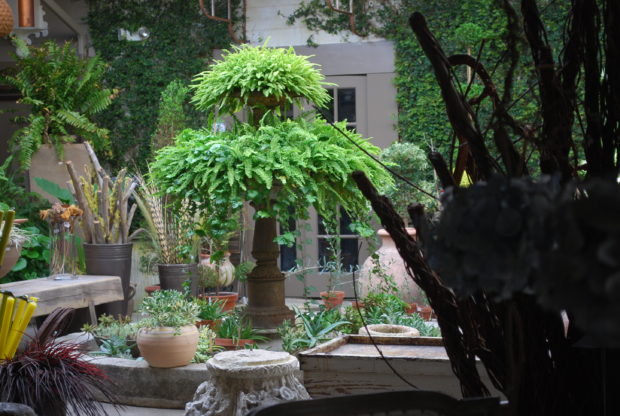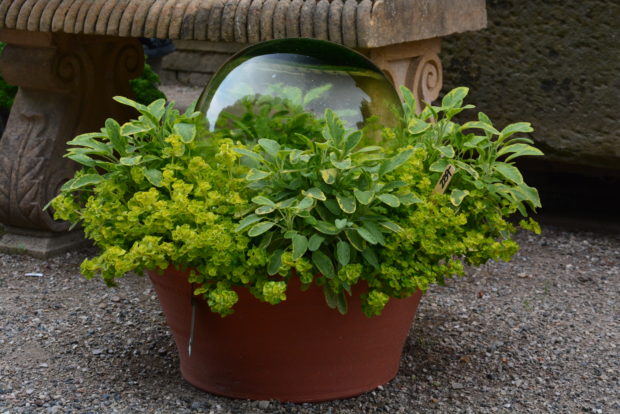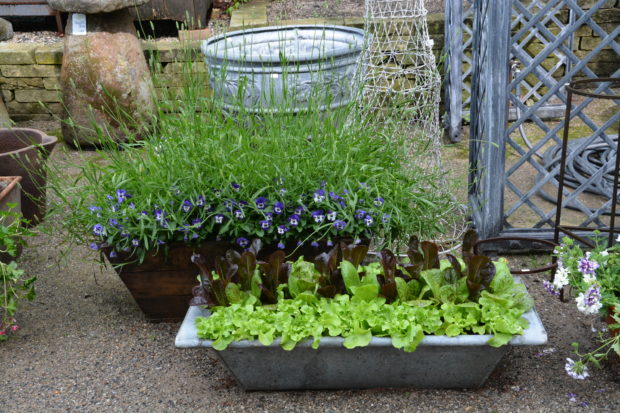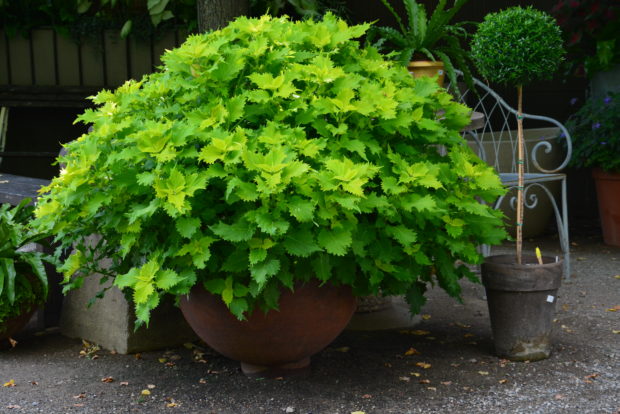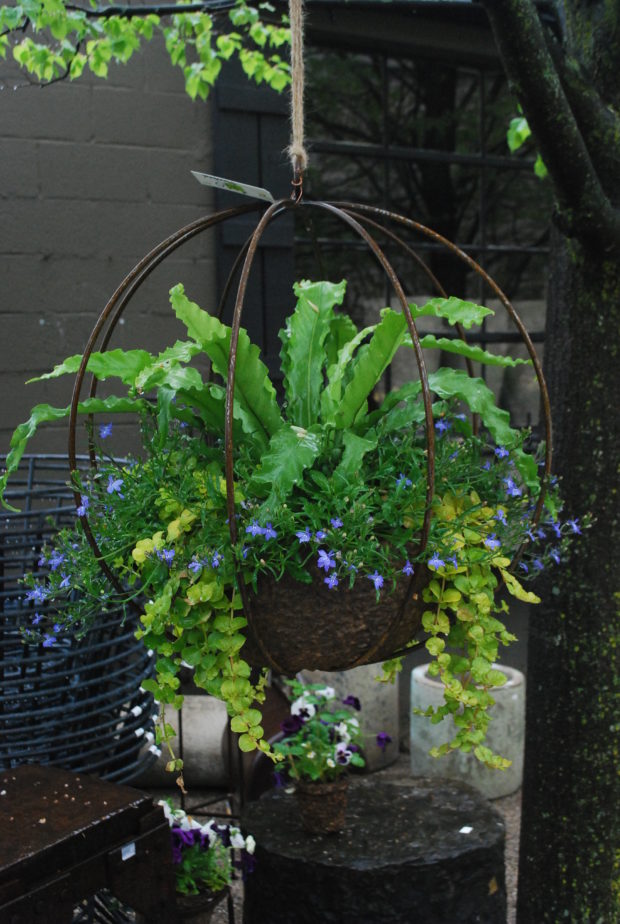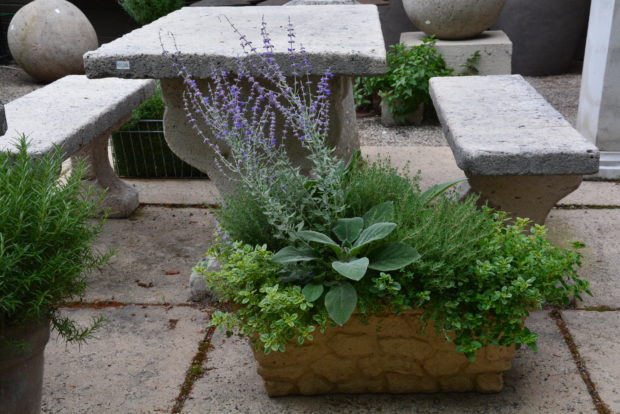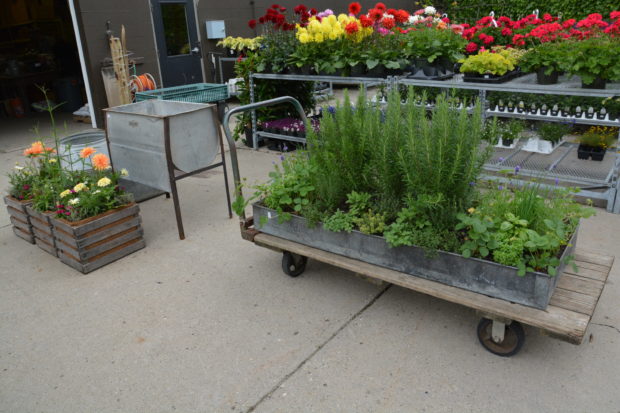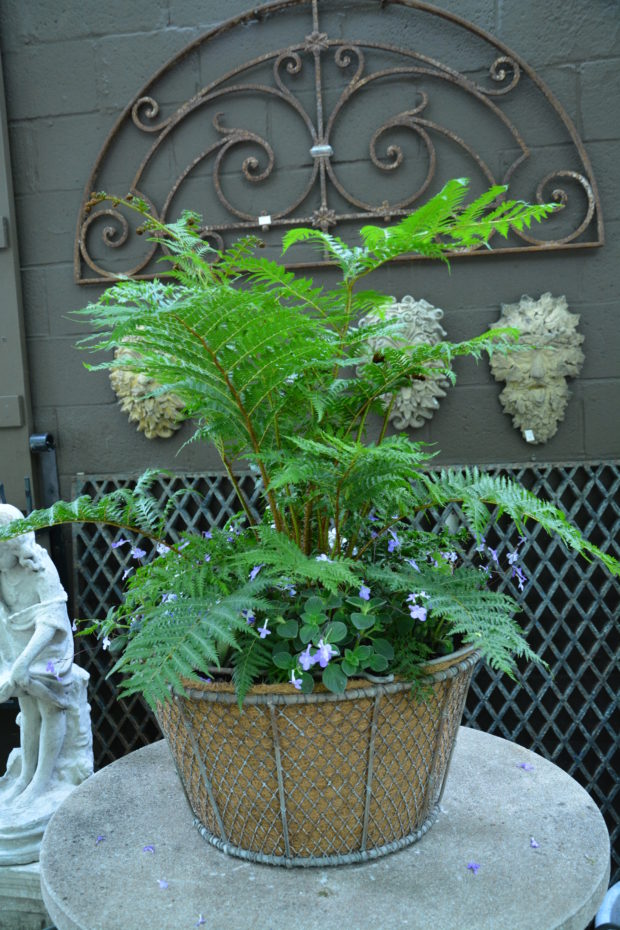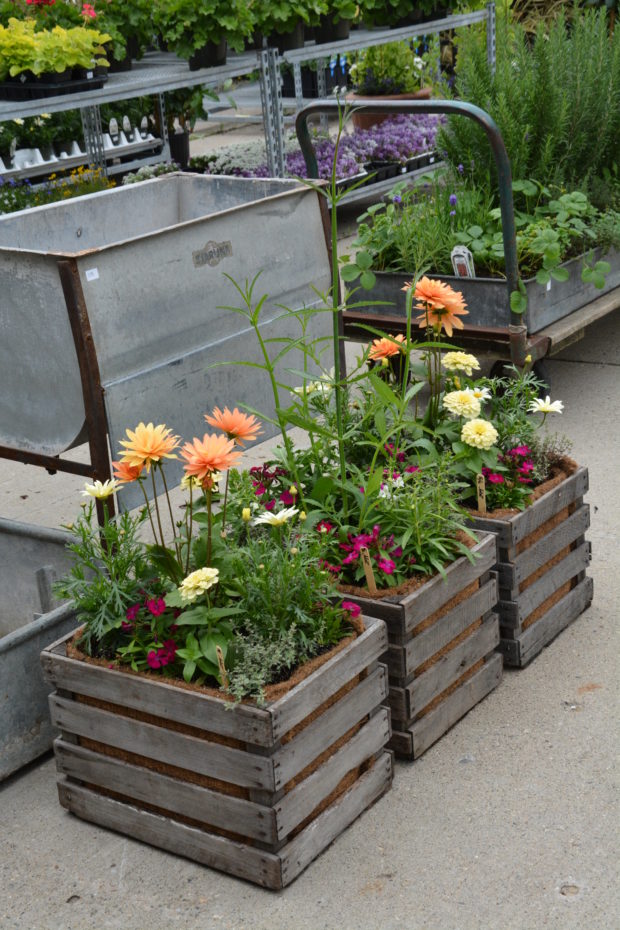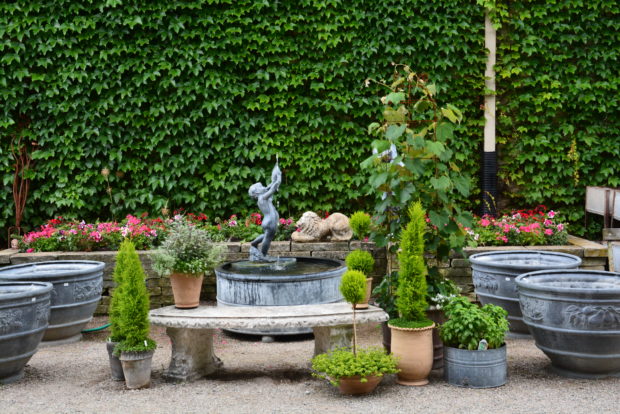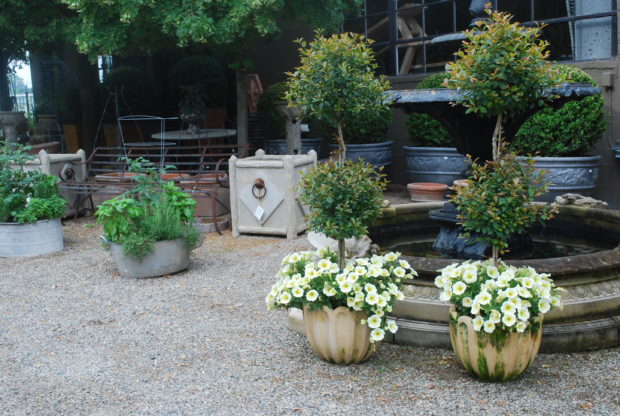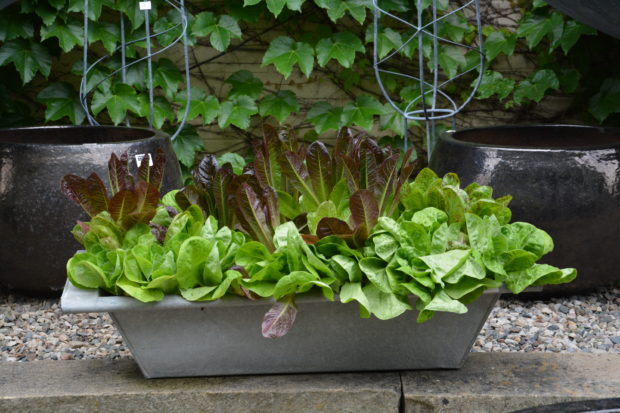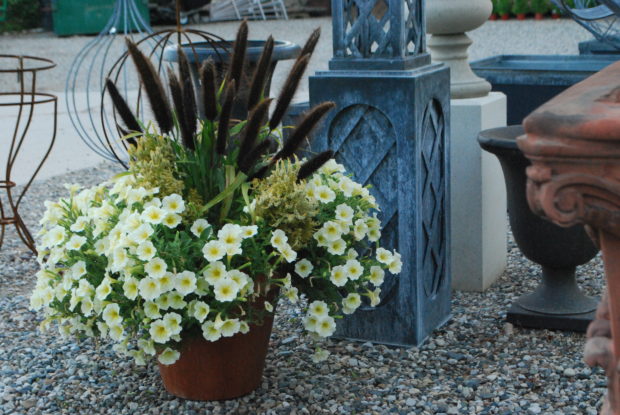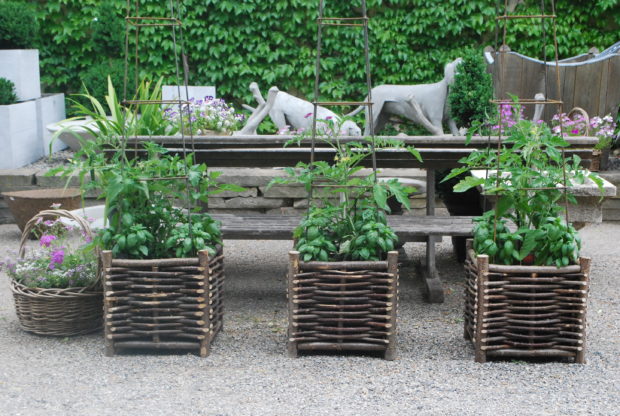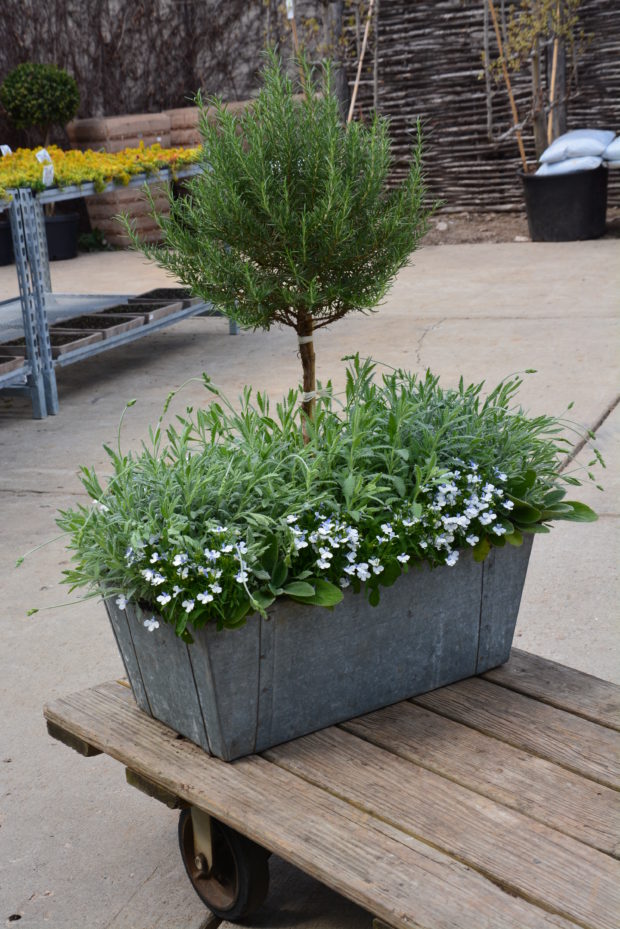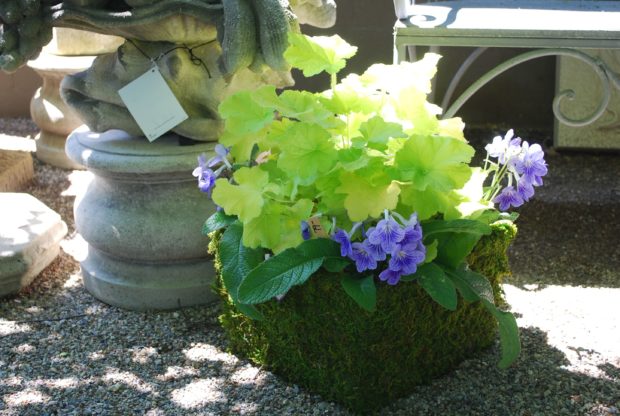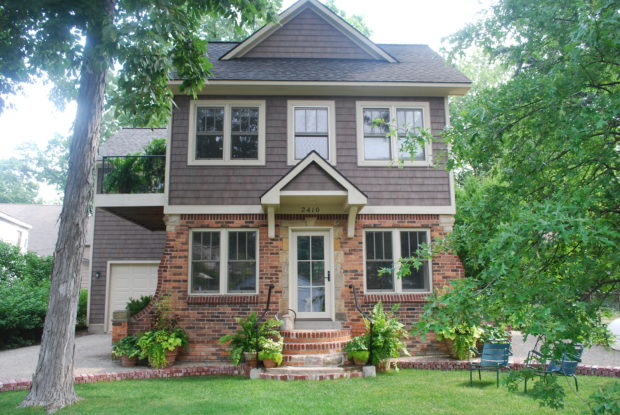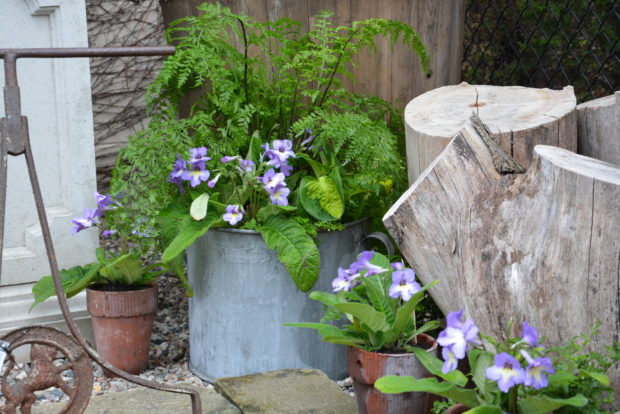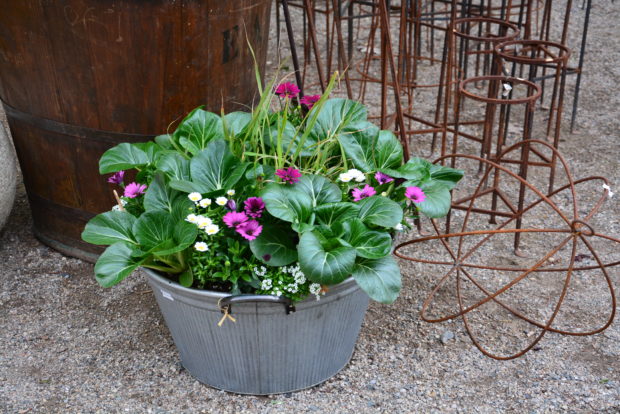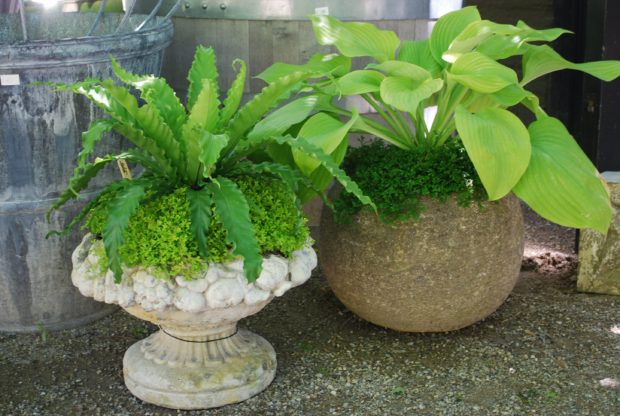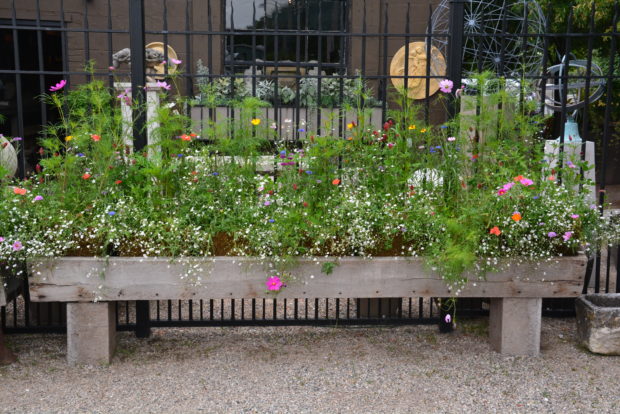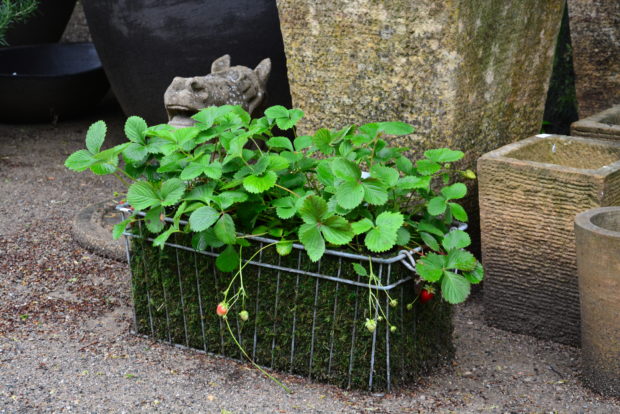 The day I go home to plant my pots for summer is a happy day indeed. I like planting my containers at home. But more importantly, it means that all of my client’s pots are done. Being last in line has its advantages. There is time to mull over a scheme. Having scouted and purchased plants for a number of projects, I take stock of what plants are out there that look interesting. Rob buys plants for the greenhouse at the shop. I shop my own shop too. A trip to pick up some trees for a landscape project may net an especially good looking specimen of an ornamental grass. When buying perennials for a garden, the future of that plant is primary. When buying perennials for containers, a handsome and well grown specimen makes that container planting look all the better. And there is time to think over the pots from last year. Surprisingly, the perennials, shrubs and trees in last year’s pots proved to be one of my favorite plantings ever. The plants grew much more than I thought they would. And the green color scheme proved to be a relaxing and refreshing change from flowers. I was inclined to try a new version of that idea.
The day I go home to plant my pots for summer is a happy day indeed. I like planting my containers at home. But more importantly, it means that all of my client’s pots are done. Being last in line has its advantages. There is time to mull over a scheme. Having scouted and purchased plants for a number of projects, I take stock of what plants are out there that look interesting. Rob buys plants for the greenhouse at the shop. I shop my own shop too. A trip to pick up some trees for a landscape project may net an especially good looking specimen of an ornamental grass. When buying perennials for a garden, the future of that plant is primary. When buying perennials for containers, a handsome and well grown specimen makes that container planting look all the better. And there is time to think over the pots from last year. Surprisingly, the perennials, shrubs and trees in last year’s pots proved to be one of my favorite plantings ever. The plants grew much more than I thought they would. And the green color scheme proved to be a relaxing and refreshing change from flowers. I was inclined to try a new version of that idea.
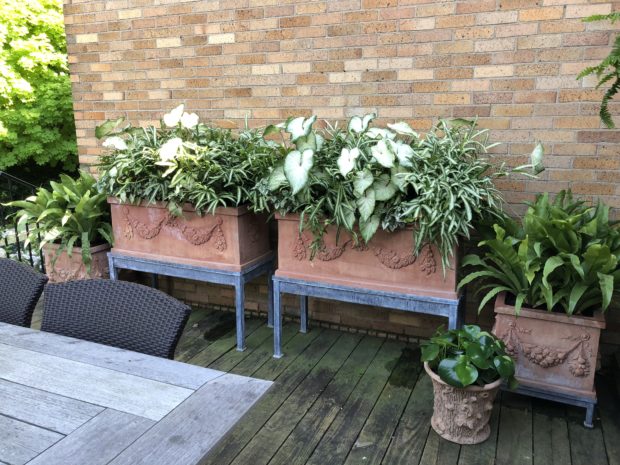 We did plant containers well into July this year. Part of that is routine. Many of my clients have us plant spring pots. In a good year, they are good into July. This year, very cold and rainy weather suited those spring pots just fine. But for those awaiting their first container planting of the season, the cold and the rain was very tough to take. Clients were not the only unhappy people. Growers had to run their heat longer than they wanted to. The gray skies meant none of the seasonal plants were growing much. The daily relentless rain kept people away.
We did plant containers well into July this year. Part of that is routine. Many of my clients have us plant spring pots. In a good year, they are good into July. This year, very cold and rainy weather suited those spring pots just fine. But for those awaiting their first container planting of the season, the cold and the rain was very tough to take. Clients were not the only unhappy people. Growers had to run their heat longer than they wanted to. The gray skies meant none of the seasonal plants were growing much. The daily relentless rain kept people away.
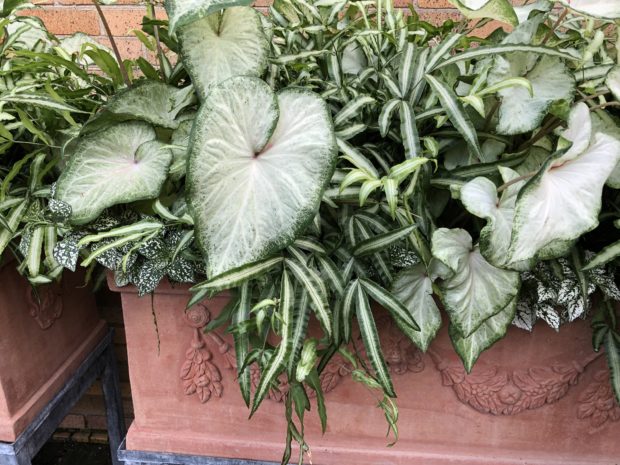 The tropical plants we did put into containers in late May had a tough time of it. Most of them are native to hot climates. They have a strong distaste for cold soil. Some were puny to begin with. Not that we lost any plants. But they sat there, and didn’t grow. Unhappy plants takes with wind out of a summer container planting. The pots we planted in June were better. The pots we planted later in June took off growing almost immediately. My plants? I had been collected them over the course of 6 weeks. They sat in the shop greenhouse, under Karen and Chelsea’s watchful eye. On a 60 degree day, that greenhouse would be 80 degrees inside. The tropical plants were flourishing in that environment.
The tropical plants we did put into containers in late May had a tough time of it. Most of them are native to hot climates. They have a strong distaste for cold soil. Some were puny to begin with. Not that we lost any plants. But they sat there, and didn’t grow. Unhappy plants takes with wind out of a summer container planting. The pots we planted in June were better. The pots we planted later in June took off growing almost immediately. My plants? I had been collected them over the course of 6 weeks. They sat in the shop greenhouse, under Karen and Chelsea’s watchful eye. On a 60 degree day, that greenhouse would be 80 degrees inside. The tropical plants were flourishing in that environment.
 These pots were planted July 7. The plants had put on a tremendous amount of growth, not being planted in my pots. They were not root bound either. The cool May and June kept the root growth slow, and by the time the warm weather finally got here, they were ready to put on a substantial amount of top growth. Especially grateful for the time in a warm greenhouse were the caladiums. They sit and sulk until the weather truly warms up. Planted out in cool soil, they may even lose ground. The variegated scented geranium column pictured above spent the winter in a greenhouse. Brought to the shop, and placed outdoors, it blew over and out of its pot a number of times. Once placed in our greenhouse, it began to grow. The tarantula shaped succulent in the bottom of the olive jar was purchased for a client who liked the hairy beast. I knew we would be left with the rest of them. I like finding homes for left over plants. It is a challenge to make them work. And I am exposed to plants I would otherwise have passed by.
These pots were planted July 7. The plants had put on a tremendous amount of growth, not being planted in my pots. They were not root bound either. The cool May and June kept the root growth slow, and by the time the warm weather finally got here, they were ready to put on a substantial amount of top growth. Especially grateful for the time in a warm greenhouse were the caladiums. They sit and sulk until the weather truly warms up. Planted out in cool soil, they may even lose ground. The variegated scented geranium column pictured above spent the winter in a greenhouse. Brought to the shop, and placed outdoors, it blew over and out of its pot a number of times. Once placed in our greenhouse, it began to grow. The tarantula shaped succulent in the bottom of the olive jar was purchased for a client who liked the hairy beast. I knew we would be left with the rest of them. I like finding homes for left over plants. It is a challenge to make them work. And I am exposed to plants I would otherwise have passed by.
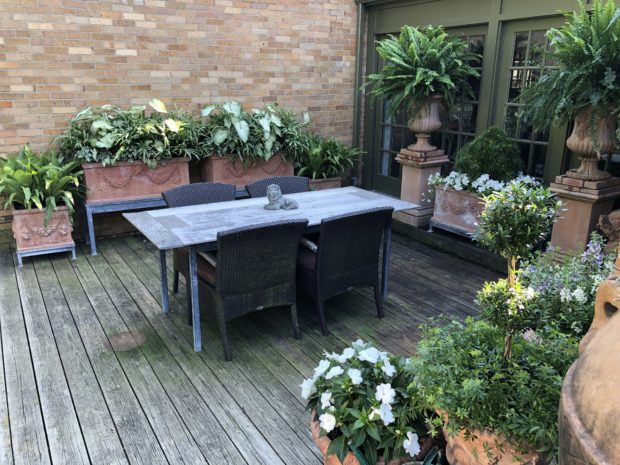 Did I like having empty containers until July? It was not half bad. Planting pots non stop for clients in the busiest part of our season did not make me long to come home to more container fussing and watering. It is not a time of year to relax in the garden and putter. It is a time to wash my hands and face, and unwind. I walk right by these containers with barely a glance, and sit in the shade next to my fountain pool. I have no scientific evidence to prove the following, but I feel annual plants that go in later in the spring and early summer can prosper into October.
Did I like having empty containers until July? It was not half bad. Planting pots non stop for clients in the busiest part of our season did not make me long to come home to more container fussing and watering. It is not a time of year to relax in the garden and putter. It is a time to wash my hands and face, and unwind. I walk right by these containers with barely a glance, and sit in the shade next to my fountain pool. I have no scientific evidence to prove the following, but I feel annual plants that go in later in the spring and early summer can prosper into October.
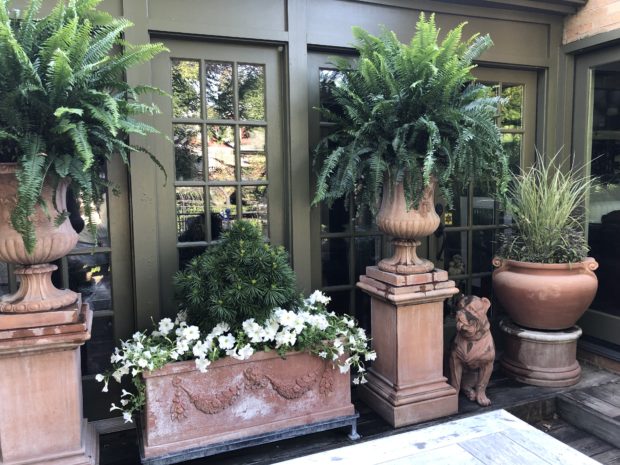 There are some issues to address with a late planting. These Kimberly ferns can take a good deal of sun providing they get enough water, but they have been grown in the shady part of the greenhouse. I will cover these with floating row cover for a week or so. This will give them time to adjust to a drastic uptick in the amount and quality of light.
There are some issues to address with a late planting. These Kimberly ferns can take a good deal of sun providing they get enough water, but they have been grown in the shady part of the greenhouse. I will cover these with floating row cover for a week or so. This will give them time to adjust to a drastic uptick in the amount and quality of light.
 Some annual plants, notably petunias, can get leggy if left in a small container too long. Combining upright white with trailing white petunias helps to mitigate the look of those legs.
Some annual plants, notably petunias, can get leggy if left in a small container too long. Combining upright white with trailing white petunias helps to mitigate the look of those legs.
 This umbrella pine spent the summer in this very pot last summer. That means stashing it somewhere for the winter, as this plant is not really hardy in my zone. It spent the winter inside my my landscape building without heat or light, and seemed to tolerate this treatment just fine. It is possible to take perennials and shrubs out of containers in the fall, plant them in the ground, and mulch them well. In ground planting in Deptember will allow a little time for new roots to form. What kills plants that go in the ground late is the ground heaving in the spring. As frost comes out of the ground, that heaving action can literally pitch plants up and out of the ground.
This umbrella pine spent the summer in this very pot last summer. That means stashing it somewhere for the winter, as this plant is not really hardy in my zone. It spent the winter inside my my landscape building without heat or light, and seemed to tolerate this treatment just fine. It is possible to take perennials and shrubs out of containers in the fall, plant them in the ground, and mulch them well. In ground planting in Deptember will allow a little time for new roots to form. What kills plants that go in the ground late is the ground heaving in the spring. As frost comes out of the ground, that heaving action can literally pitch plants up and out of the ground.
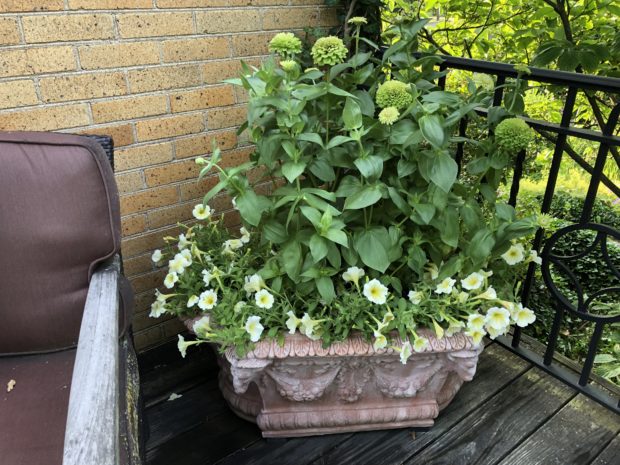 Zinnias become very root bound in 4″ pots. They are big growing plants, and they grow fast. Though they are difficult to handle once they get tall, it is amazing how readily they will root into a container and keep on growing. Other summer annuals are not so obliging in this regard. If it is a plant that you must have, a little judicious pruning of the top might encourage new growth. If the roots have grown around and around in a circle, some untangling or ripping could be beneficial. But plants do have a shelf life. Whenever I shop for plants, I will gently knock the plant out of its pot to see if there is a good root system. Plants that have been repeatedly over watered can have compromised root systems. Rotted roots means a plant cannot absorb any water, no matter how much is available.
Zinnias become very root bound in 4″ pots. They are big growing plants, and they grow fast. Though they are difficult to handle once they get tall, it is amazing how readily they will root into a container and keep on growing. Other summer annuals are not so obliging in this regard. If it is a plant that you must have, a little judicious pruning of the top might encourage new growth. If the roots have grown around and around in a circle, some untangling or ripping could be beneficial. But plants do have a shelf life. Whenever I shop for plants, I will gently knock the plant out of its pot to see if there is a good root system. Plants that have been repeatedly over watered can have compromised root systems. Rotted roots means a plant cannot absorb any water, no matter how much is available.
